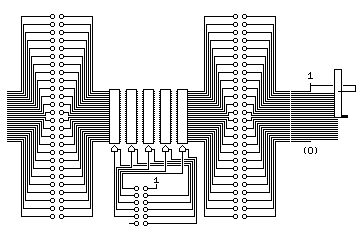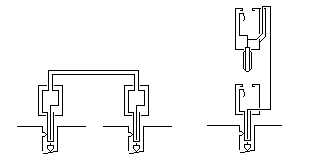
The M-134 and the M-229, as described in the section on the SIGABA rotor machine, have suggested to me the idea of a very flexible style of rotor machine, one which could even be used, if made from plastic, as an educational children's toy!
As a toy, the heart of it would be three rotor machines of the type diagrammmed below.

These machines consist of a bank of five rotors. At each end, there is a plugboard like that of the Enigma, but using standard phono plugs. Beyond the plugboard, on each side, there is a 26-contact connector used to connect a keyboard and a lampboard, only one of each being included in the set. The keyboard would also have a 26-contact connector; plugging the lampboard into that connector would allow the Enigma to be simulated.
The machine would use rotors that have plastic slip rings on the outside with bumps to control rotor motion, signalling a carry from one rotor to the other. The rotors and the rings would both be reversible.
The complement of rotors provided would be:
All the slip rings would have only one bump on one side. They would have multiple bumps on the other side, and there they would differ.
As noted, the plugboards on the device use phono plugs, and work like that on the Enigma, so that straight-through wiring is the default when no plugs are inserted.
The cables provided with the machine will have the forms illustrated in this diagram:

Although it may not be obvious, the first cable crosses over the two parts of the contact. The complement of cables would be:
The kit would include plans for many projects, starting with a Hebern rotor machine, going on to an Engima, and then the SIGABA, and even a small Turing bombe for use against a two-rotor Enigma. (Maybe that would require some additional pieces not mentioned here. And, of course, I'd have to come up with a way to manufacture an economical diagonal board.)
U. S. Patent 6097812 has recently been granted on the design used in the M-138 (and M-138-T2 and M-138-A) cipher machine, and this design combines the M-138 with the M-228 and M-229, and hence is likely to be affected by this patent.
Next
Skip to Next Chapter
Chapter Start
Table of Contents
Main Page